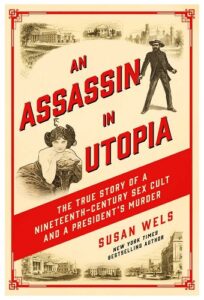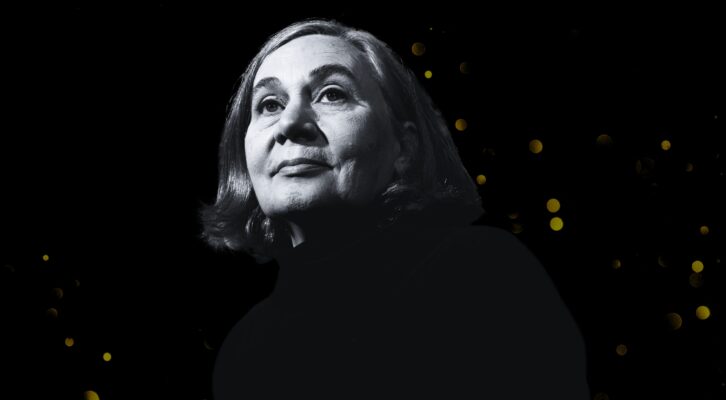John Humphrey Noyes, in his youth, was so painfully shy that he could barely endure the company of women. “I could face a battery of cannon with less trepidation,” he wrote in his diary, than “a room full of ladies with whom I was unacquainted.” Born in 1811 on the Vermont frontier, he was the fourth of nine children of John Noyes Sr., a former congressman, and flame-haired Polly Hayes, whose nephew—the feeble, emaciated Rutherford B. Hayes—would grow up to become the nation’s nineteenth president.
John Humphrey was a precocious student, and he enrolled in Dartmouth College at fifteen. He went on to study law, but his shyness was so paralyzing that he stammered and stuttered through his first court appearance. Crushingly self-conscious, he felt daunted by life’s uncertainties—until the fall of 1831.
Religious revivals were inflaming New England that year. Farmers, backwoodsmen, and frontier families flocked to these frenzied emotional festivals—wailing, jumping, barking, and speaking in tongues in ecstatic expressions of salvation. John Humphrey had little interest in these displays, but after attending a four-day meeting, he felt transformed. Dedicating himself to God, he left the law and entered the Andover Theological Seminary in Massachusetts. He soon found it too hidebound for his religious zeal, so he transferred to Yale Divinity School. A liberal theologian there, Nathaniel Taylor, urged him to seek his own truth, even “if it carries you over Niagara Falls.” Through study and revelation, Noyes found and announced his truth—that he was a perfect human, incapable of sin. God, he said, gave him special protection. But his fellow students declared him crazy, and Yale nearly expelled him. He was stripped of his license to preach, but Noyes began traveling to promote his gospel. In the winter of 1835, the twenty-three-year-old set out to win converts in Massachusetts. When he arrived in Brimfield with a fellow preacher named Simon Lovett, the free-thinking, religiously inflamed townspeople welcomed them with rare enthusiasm. One young woman, inspired by Noyes’s shining gray eyes and expressive manner, kissed him seductively when he said goodnight. Panicked by her advances, Noyes, still blushingly shy, fled Brimfield that night, telling no one, and trudged sixty miles, through snow and temperatures below zero, to his family’s homestead in Putney, Vermont.
Lovett, meanwhile, remained in Brimfield. One night, two young townswomen—Mary Lincoln and Maria Brown—slipped into that preacher’s bed to test the power of their faith. They aimed to prove their religious zeal by showing that the spirit could always win out over physical passion. Predictably, however, Noyes later recounted, “flesh triumphed over spirit.” The sexual scandal that resulted—infamously known as the “Brimfield Bundling”—was so explosive that Mary Lincoln fled to a mountainside, stripped off her clothes, and pleaded with God not to set Brimfield afire. The whole sordid episode was blamed on Noyes, although he had no part in it, having fled the town.
But Noyes chose to embrace that notoriety and soothed his own sexual jealousy over the next two years by professing a maverick theology. After a young woman he loved married another, Noyes—filled with anguish and envy—declared that, when God’s will was done, marriage and sexual exclusiveness, guilt, and jealousy would no longer exist on earth. “In a holy community,” he wrote to a friend, “there is no more reason why sexual intercourse shall be restrained by law than why eating and drinking should be, and there is as little occasion for shame in the one case as in the other.” His declaration was published in 1837, to widespread outrage, but Noyes threatened to shout his new theology from the rooftops. “I cared nothing for reputation,” he said, and vowed never to join any religion again “unless I was the acknowledged leader.”
He was only twenty-six and still a bashful virgin. But in 1838, he married a practical, plain disciple named Harriet Holton. Their marriage, he told her, would be open and unsentimental. They would each be entirely free to love other people. But Harriet, an heiress, would be able to finance his passion for publishing his religious doctrines. The newlyweds spent their honeymoon in Albany, New York, purchasing a printing press.
Newspapers were a thriving business in the 1830s. There were twice as many of them in America as there had been in 1810. Alexis de Tocqueville, a French aristocrat who traveled the young country in 1831, was amazed at the number of periodicals. Every village, he reported, had a newspaper, and the power of the press was impressive. Noyes—God’s self-anointed messenger—planned to launch a religious newspaper that would serve as the pulpit of the world.
As early as 1834, he had published a monthly in New Haven called The Perfectionist. It quickly attracted more than five hundred subscribers. Three years later, he launched a new paper, The Witness, in upstate New York, but he distributed only a few issues. Now, back in Putney, he and Harriet planned to ignite a new religious revival through the printed word. Noyes recruited three of his eight siblings to help with the publication and attracted a small coterie. Within five years, he had more than thirty disciples, who drafted and signed a “Statement of Principles”: “John H. Noyes,” they pledged, “is the father and overseer whom the Holy Ghost has set over the family thus constituted. To John H. Noyes . . . we submit ourselves in all things”—including carnal relations.
Two followers, Mary and George Cragin, agreed to join John and Harriet Noyes in a group marriage. Other converts soon followed their lead. Although the arrangements were an open secret, townspeople in Putney were outraged after Mary Cragin gave birth to Noyes’s twins—Victor and Victoria—and authorities learned about the group’s conjugal customs. In October 1847, Noyes was arrested and charged with adultery and fornication. Fearing mob violence, he fled the village.
Weeks later, he found refuge in central New York, with a follower named Jonathan Burt. The owner of a sawmill on Oneida Creek, Burt had read about and passionately embraced Noyes’s theology. He invited the Putney group to settle on land adjoining his forty acres of fields and woodland. The property, once owned by the Oneida Tribe, had a barn and a primitive cabin on twenty-three rolling acres. Noyes purchased the land for five hundred dollars and summoned his devoted band.
***
On an icy March day in 1848, his wife, Harriet, and Mary and George Cragin arrived by train at the Oneida depot. Blasted by the biting wind, the three disciples gazed out at a bleak landscape of barren snowdrifts and bare trees. Soon, bundled into open sleighs, they made their way across frozen fields, where they would transplant the seeds of their new religion.
They were not the first to find fertile prospects in upstate New York. It was a hotbed of eccentric theology. In 1776, an Englishwoman named Ann Lee had settled near Albany with a few followers. She claimed she was the female embodiment of a bisexual God, and her disciples committed to complete celibacy. The sect, known as the Shakers, grew from nine original members to six thousand by the 1840s.
In 1823, in Palmyra, New York, a teenage treasure hunter named Joseph Smith claimed he had found golden plates inscribed with the true gospel. He later alleged that he had translated their hieroglyphics into The Book of Mormon and founded a new religion based on local New York legends about a pre-Indian race and the radical practice of polygamy.
Rochester, New York, was the hub of a massive movement founded by William Miller. In 1831, Miller, a Baptist preacher, declared that the world would end in 1843, a prediction widely promoted in a newspaper called Signs of the Times. Thanks to an aggressive publicity campaign, as many as a million Americans were waiting for the ecstatic moment when the wicked would burn up and God’s children would fly into the sky to meet the Lord. Believers were said to abandon their crops, shut their businesses, and wait for the rapture in white ascension robes. The frenzy of anticipation was so great that the New York Tribune published a special issue refuting Miller’s predictions. The American Journal of Insanity warned that thousands of American citizens had become deranged.
After 1843 came and went without the rapture, Miller revised his calculations and declared that the world would end, instead, on October 22, 1844. On October 21, disciples climbed trees and hills to be closer to heaven, but they were still earthbound on the twenty-third. The celestial flop, known as “The Great Disappointment,” was reported in papers around the country. Believers had been “up a few nights watching and making noises like serenading tom cats,” wrote the Cleveland Plain Dealer, before they gloomily gave up and went to bed.
The region was so aflame with religious fever that it was later called the Burned-Over District. But social and religious experiments had bloomed across the country after the War for Independence. The revolution had shattered institutions and traditions. Charismatic leaders filled the void with new, imaginative social structures. In America’s new democracy, any man could do pretty much as he pleased, declared the New York Tribune’s founder, Horace Greeley. The individual was the world, said philosopher Ralph Waldo Emerson, and almost every reading man had “a draft of a new community” in his pocket. Inspired by faith in freedom and divine revelation, Americans launched more than seventy utopian experiments between 1800 and 1860.
Some, like New Harmony, Indiana, were secular communities. Founded by a Welshman named Robert Owen in 1825, New Harmony was formed “to promote the happiness of the world” through communal benefits and cooperation. In its first weeks, eight hundred people joined the community, but by 1828, New Harmony was divided into fighting factions and dissolved in discord. Other utopias, like the Kingdom of Matthias, promised disciples divine salvation. Its founder, Matthias, was a carpenter named Robert Matthews. In the early 1830s, he announced that he was God the Father and Jesus Christ. He strolled Manhattan in a coat embroidered with silver stars, carrying a great key to the gates of paradise. Matthias soon moved into a follower’s mansion in Westchester, New York, where he attracted a community of devoted converts. In a ritual called the “Fountain of Eden,” members of his kingdom would surround him, naked, in a circle while Matthias sluiced them with a sponge and declared them virgins.
The spirit of the age was singularity. As Emerson urged, “A man must be a nonconformist.” Life in America in the early nineteenth century was a grand experiment in which every man, he wrote, could build his own world.
***
In 1848, John Noyes’s world on Oneida Creek was bleak and frigid. After they arrived by sled at his crude homestead, Harriet and the Cragins moved into the log hut, with its single room, but soon built shelters for families who followed from New York, Vermont, and Massachusetts. By the end of the year, there were eighty-seven men, women, and children in the new community. Together, they constructed a three-story mansion, with sleeping quarters for a hundred people. The bedrooms were still unfinished in December, so the whole community moved into a thirty-by-thirty-five-foot room on the second floor. They divided the space into twelve compartments, flimsily separated by hanging sheets.
Neighbors whispered about the group sleeping chamber, and scandalous tales multiplied when Noyes published his First Annual Report. The document chronicled the assets, members, and history of the Oneida Community. As a branch of the Kingdom of Heaven, Noyes wrote, the society banned private property, monogamy, and sexual shame. Physical union, he maintained, was as holy as the Garden of Eden and God in heaven. And perfecting it as a form of worship, Noyes insisted, required what he called “male continence”—the suppression of ejaculation. Members mastered this technique through careful practice. As Noyes explained, a boatman, approaching a waterfall, would reach “a point on the verge of the fall where he has no control over his course.” But if he was willing to learn, “experience will teach him” how to remain, devoutly, in “the region of easy rowing.” Noyes was eager to send his report to a wide audience, including the governor of New York and Horace Greeley at the Tribune. He was sure that Oneida’s publications would draw legions of new followers. From his printing office at Oneida, he mailed his weekly newspaper, The Free Church Circular, to everyone who wanted it, with no charge. He was certain of the power of religious journalism and aimed to create a theocratic daily modeled on Greeley’s popular New York Tribune.
So when a fire destroyed his press in early 1849, Noyes seized the opportunity to move his publishing office to New York City, where he could reach people of importance and influence. By April of that year, he had set up a satellite branch of the Oneida Community in Brooklyn, on Willow Place—with a brand-new printing press, a staff of reporters, and easy access to railroads, telegraphs, and steamboats. He soon managed to give copies of his First Annual Report to Greeley and to Henry James—an eccentric intellectual who was the father of Henry James, the novelist, and William James, the psychologist and philosopher. The senior James was a frequent visitor at Willow Place and encouraged Noyes to share his ideas and theology as widely as possible.
Upstate, too, the Oneida Community won many friends, despite their exotic practices. Members considered themselves a family, and its head was indisputably John Noyes. His power over his followers was so complete that even his own mother called him “teacher and father.” He controlled his subjects through a process called “mutual criticism,” in which members appeared before a committee that frequently humiliated them with brutal critiques of their personalities and actions. Noyes alone was exempt from criticism—but a challenge soon came from Oneida County’s district attorney.
___________________________________
Excerpted from An Assassin in Utopia: The True Story of a Nineteenth-Century Sex Cult and a President’s Murder, by Susan Wels. Copyright, 2023. Published by Pegasus Books. Reprinted with permission. All rights reserved.
















